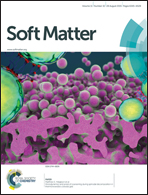Heat-set gels formed from easily accessible gelators of a succinamic acid derivative (SAD) and a primary alkyl amine (R-NH2)†
Abstract
Currently, the design and construction of an intelligent stimuli-responsive gel system is still a significant challenge. We present here a new gel system from which the formation of heat-set gels, conventional gels and irreversible heat-set gels can be achieved in aromatic solvents. This gel system is based on two-component gelators containing a succinamic acid derivative (SAD) and a primary alkyl amine (R-NH2). With the increase of temperature to 85 °C, a rarely reported reversible heat-set gel (gel formation with the increase of temperature) is afforded. Upon addition of fatty acids into two-component gelators, a conventional gel (gel formation with the decrease of temperature) is formed. When the fatty acid is replaced with dicarboxylic acid, a new heat-set gel is generated, which is irreversible and thermally super-stable. X-ray diffraction analysis reveals that the formation of a reversible heat-set gel relies on electrostatic interactions, hydrogen bonds, and hydrophobic interactions. These two-component gelators show a perfect gel system for the formation of diverse gels including heat-set gels, conventional gels and irreversible heat-set gels. The tunable strategy demonstrated in this letter may provide a new way for creation of more functional gels in gel science.



 Please wait while we load your content...
Please wait while we load your content...